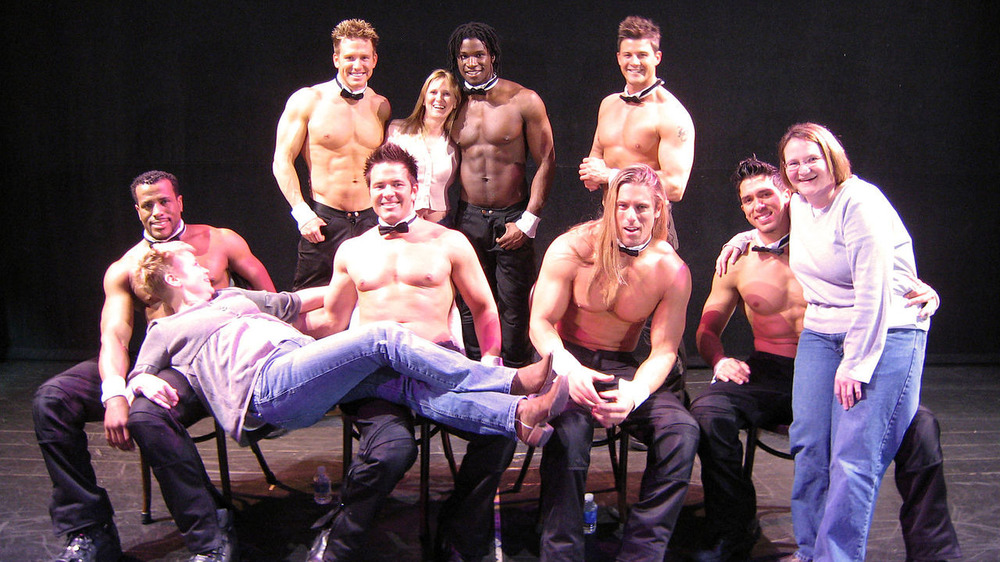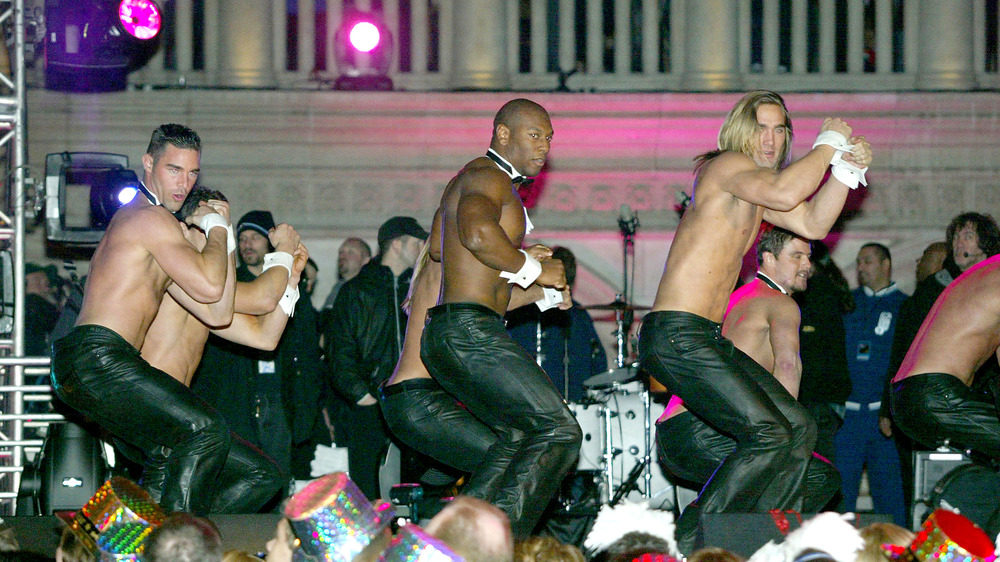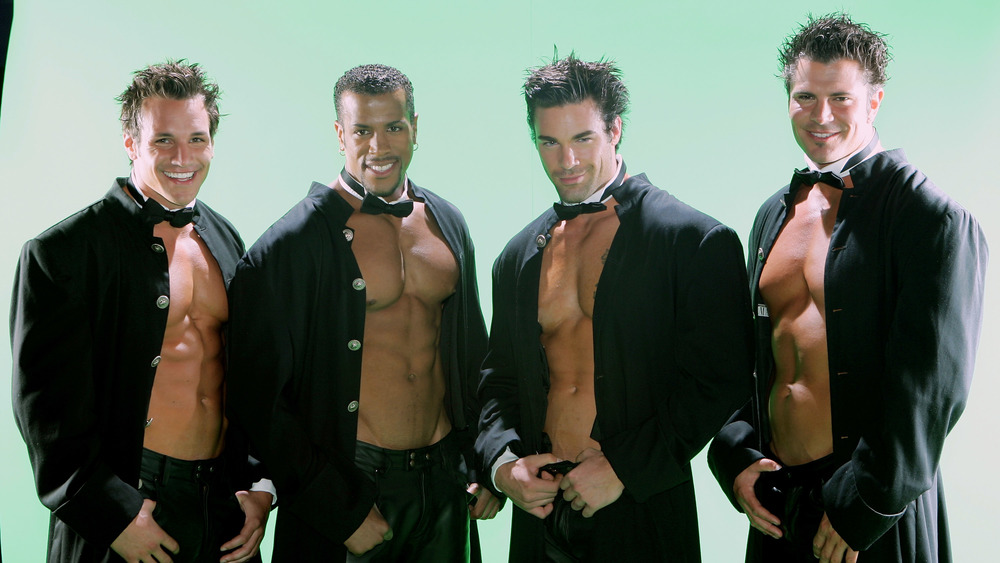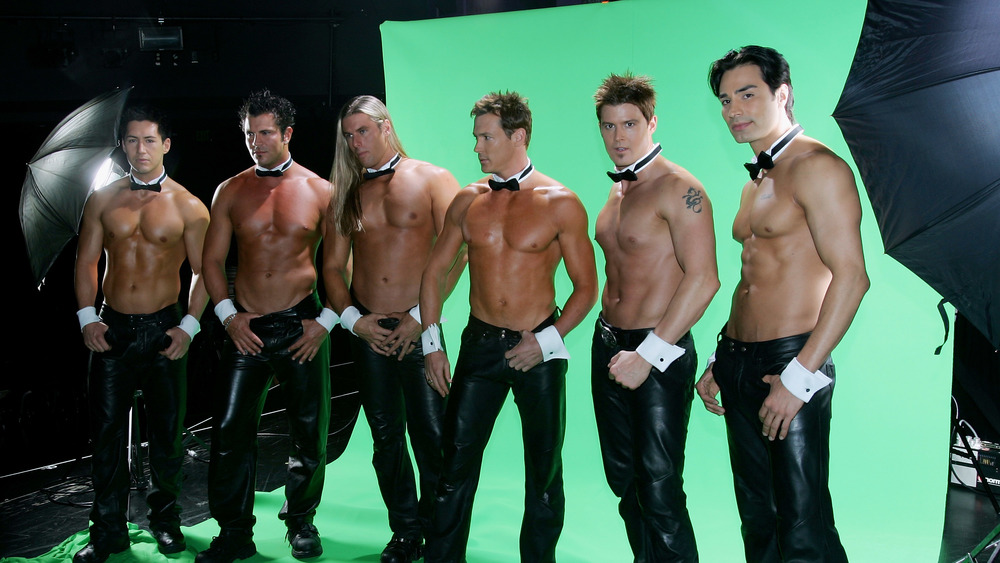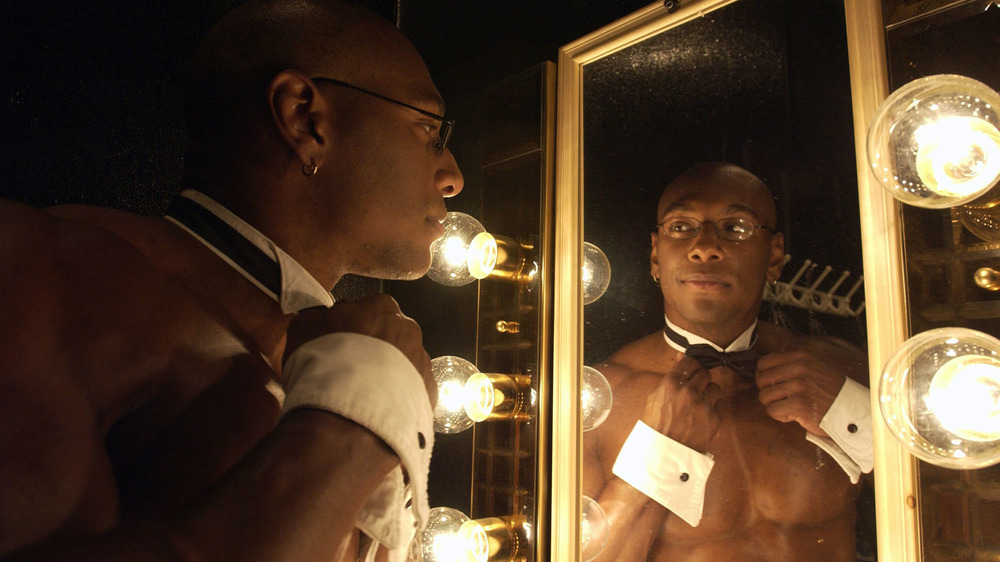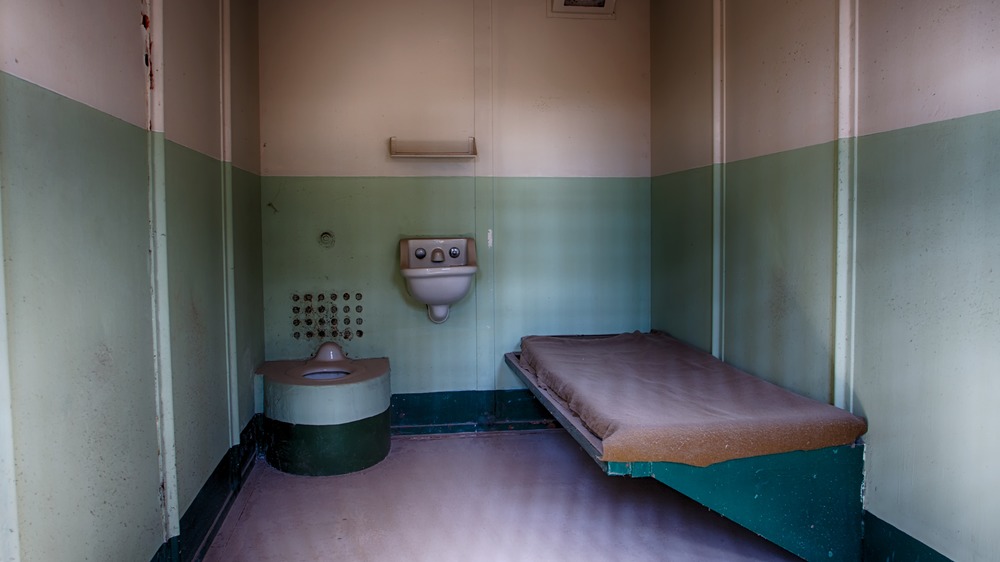The Surprisingly Dark History Of Chippendales
Chippendales has become an iconic American institution, right up there with jazzercise and fried Oreos. Just hearing the name conjures up instant images of oiled-up guys with flexing pecs wearing bow ties and very little else, gyrating for a crowd of screaming ladies—or possibly Chris Farley and Patrick Swayze in one of the greatest Saturday Night Lives sketches ever aired. The Chippendales image is so powerful that more than four decades after its inception it continues to be a multi-million dollar business.
But if your knowledge of Chippendales ends there, you're missing out on a story where the rise of feminism, the American immigrant dream, and greed combine to create one of the darkest and twistiest stories in recent memory. You might think Chippendales is just a holdover from the tacky late 1970s, a relic of a time when ladies going to strip clubs was considered risqué—but the true story of Chippendales includes arson, hired assassins, and incredibly dumb business decisions, all fueled by jealousy, insecurity, and greed. Here's the surprisingly dark history of Chippendales.
The founder of Chippendales was a hard-working immigrant
Chippendales is a uniquely American creation, but the man who originally founded the business immigrated to the United States from India. As reported by Los Angeles Magazine, Somen "Steve" Banerjee came to this country like so many others seeking the American Dream—and he worked hard at it, taking a job as a janitor and working his way up to owning several Mobil gas stations in Los Angeles.
In 1975, Banerjee decided to expand his business empire. With his business partner Bruce Nahin, he purchased a local L.A. nightclub, naming it Destiny II. Banerjee had a dream of being the owner of a "classy" club, a place he could walk into and feel like a big shot.
But as Eagles Vine reports, that business decision didn't work out as planned—the club failed to attract crowds and become a money maker. Nahin and Banerjee tried several desperate gimmicks to get people into the club, including backgammon games, dinner theater, wrestling nights—even magic shows. But nothing worked. But that didn't stop Banerjee, who had never shied away from hard work as he made his way up the ladder of success—and the final gimmick they tried, an all-male strip show, launched the club into instant success.
The idea for male strippers came from a notorious murderer
When seeking business advice, it's usually a good idea to avoid people with a high potential for becoming murderers. Unfortunately, this is advice that Steve Banerjee, the founder of Chippendales, failed to heed.
As Los Angeles Magazine notes, one of the regular customers at the club Banerjee and Bruce Nahin launched, Destiny II, was a guy named Paul Snider. Snider was a sketchy guy who liked to refer to himself as "The Jewish Pimp." As reported by People, Snider had gained some fame through his wife, Playboy Playmate Dorothy Stratten. Snider promoted Stratten, photographing her and launching her career as a nude model—but he also abused her terribly, and would murder her and kill himself in 1980.
But in 1979, Snider and Stratten were instrumental in the launch of Chippendales. Snider suggested an all-male strip show to Banerjee, and as Rare notes Stratten actually came up with the iconic outfit of bow ties and cuffs and nothing else. The idea hit at a sweet spot in American cultural history with the women's liberation movement and the mainstreaming of sex—erotic films were being released in theaters with splashy premiers. The name Chippendales was taken from the 18th century furniture designer because Banerjee thought the name evoked "pure class."
Chippendales was white-centric
Just as it is today, Los Angeles in 1979 was an extremely diverse city, with many neighborhoods celebrating various ethnic and cultural backgrounds. That was one reason it was an ideal destination for an ambitious immigrant like Steve Banerjee in the first place. So you might be forgiven for thinking that Banerjee would want to make his male strip show as diverse as possible. But when Banerjee launched Chippendales, the iconic male revue, there were almost no dancers of color.
As reported by Los Angeles Magazine, historian and podcaster Natalia Petrzela explains that in the early days of the club the dancers Chippendales hired were almost exclusively white. Banerjee was obsessed with having a "classy" club, and according to Petrzela, for the Indian immigrant "classy meant white." In fact, Chippendales was a largely white island in the midst of one of the US's most diverse cities—white dancers performing for audiences that were also overwhelmingly white.
As time went on and the brand became nationally recognized, they did hire the occasional Black dancer to perform—but typically just one at a time, so that the main group of dancers remained largely white.
The owner literally tried to burn Chippendales competition down
The more you learn about the history of Chippendales, the more you realize that its co-founder, Steve Banerjee, wasn't exactly the best businessman. But after hitting on the idea of an all-male strip show, his club became an enormous success. As reported by The New York Post, every night there were lines around the block as hundreds of women would pay a lot of money to crowd into the club and be entertained by the buff, oiled male dancers on stage.
That kind of success naturally inspired others to try and imitate the Chippendales recipe. Faced with competing local clubs that sapped some of his business, Banerjee could have upped his game or found ways to innovate. Instead, as the Associated Press notes, he attempted to hire people to burn down at least two competitors: Moody's Disco in Santa Monica and the Red Onion Restaurant in Marina Del Rey. As Think Magazine reports, both attempts were unsuccessful: the competing clubs suffered only minor damage, and as Chippendales' fame grew copycats began to spring up nationwide, making arson an ineffective strategy.
As the Los Angeles Times notes, Banerjee seemed to get away with the attempted arson, but was eventually indicted on both counts—and pleaded guilty.
Chippendales owner Steve Banerjee was insanely jealous of Nick De Noia
Nick De Noia was a successful television producer. Hired by Steve Banerjee in 1981 to class up the dance routines and stage productions at Chippendales, he quickly outclassed the founder of the business in every way. As reported by Los Angeles Magazine, De Noia came up with the gimmicks and costumes that really put the club on the map, including routines based on Frankenstein, superheroes, and the legendary "Unknown Flasher" who performed wearing a paper hat.
As The New York Post reports, De Noia also convinced Banerjee to sign away lucrative aspects of the business, allowing De Noia to run an East Coast version of the club and a touring production more or less independently—and to keep most of the profits. Worse, De Noia started becoming the face of Chippendales. As the brand grew in fame and value, it was De Noia who showed up on television shows like The Sally Jessy Raphael Show and Donahue. Banerjee began to seethe with jealousy, because he felt that his contribution as co-founder was being forgotten. He also felt that De Noia was taking credit for his idea—and the media was letting him.
Steve Banerjee was cheated by his Chippendales business partner
Chippendales was an instantaneous success and a cultural phenomenon—but its success was initially due to its novelty. Just as sex was going mainstream and there was a demand for a safe space for women to express their own sexuality and fantasies, a club featuring attractive, oiled-up men stripping down on stage appeared.
But as Eagles Vine reports, Steve Banerjee knew that if he wanted to keep up that level of success and take Chippendales to the next stage, he needed to elevate the production values of the show. In 1981, he hired Nick De Noia, an Emmy Award-winning television producer, to make the shows at Chippendales more professional. From the beginning, De Noia and Banerjee didn't get along, fighting over who was in charge.
As Oxygen reports, Banerjee became jealous of De Noia and the attention he got—especially when people assumed De Noia was the club's founder. But things went from bad to worse when De Noia floated the idea of creating an East Coast version of the show. He jotted down an agreement on a napkin that gave him independent control over the new endeavor—and a 50 percent cut of its revenue. Banerjee signed, but apparently didn't understand that the language granted De Noia control in perpetuity.
Steve Banerjee made terrible financial decisions
Compounding Steve Banerjee's sense of jealousy and anger was the fact that he really wasn't a great businessman, and he mishandled his finances pretty badly.
As noted by The New York Post, Banerjee's problems began when he simply failed to pay his taxes. As the bill for his back taxes swelled, he compounded his financial problems with other mistakes. Lending the Chippendales name to merchandise was a great idea, and a project to create a sexy calendar featuring the half-naked dancers in steamy poses was a surefire hit—but Banerjee mishandled the whole thing and wound up with a calendar where every month had 31 days. The reprint cost him $70,000—close to $200,000 in today's money.
Banerjee also miscalculated when he let his jealousy of partner Nick De Noia get the better of him. After hiring De Noia to improve the performances, Banerjee became incensed when De Noia began appearing on television, celebrated as the genius behind the club. De Noia had created a successful touring version of the show and, as Eagles Vine reports, Banerjee decided to create a competing West Coast tour. But De Noia sued because Banerjee had given him the legal rights to that idea, and the lawsuit devastated Banerjee's finances even further.
Steve Banerjee hired a hit man to kill his Chippendales business partner
When faced with internal disagreements, most business professionals pursue legal remedies—they sue, or have their lawyers negotiate a settlement. It's a slow and often frustrating process, but it has the advantage of keeping everyone alive and out of jail. When Steve Banerjee decided he'd been treated badly by the man he hired, Nick De Noia, he decided to take a decidedly different route for justice: He hired an assassin.
According to Oxygen, Banerjee hired De Noia in 1981 to elevate the show's production values. De Noia had a background in television and knew how to stage things, and he had an immediate impact on the overall quality of the performances. But as The New York Post notes, De Noia was also a ruthless businessman who basically tricked Banerjee into signing away control of what would become the most lucrative aspect of the business—in perpetuity. And Banerjee became jealous of De Noia's public appearances and celebrity, feeling that he was the founder and thus should be getting that attention.
As reported by Los Angeles Magazine, that jealousy and anger led Banerjee to hire a hit man named Ray Colon in 1987 to kill De Noia. Eagles Vine reports that Colon farmed the job out to a local drug addict named Louie, who posed as a messenger and walked right into De Noia's office and shot him in the face.
Steve Banerjee also planned to have Bruce Nahin murdered
Like an incompetent Michael Corleone settling all the family's business, Steve Banerjee wasn't plotting just one murder in 1987—he was plotting two.
Banerjee bought the club that would become Chippendales with business partner Bruce Nahin in 1979, and in 1987 Nahin remained a co-owner of the business. After hiring Nick De Noia to improve the production values of Chippendales' strip shows, Banerjee became increasingly jealous of the credit De Noia was receiving—and increasingly angry about the fact that De Noia was making the bulk of the money. So as Los Angeles Magazine reports, he hired a hit man to kill De Noia in 1987.
Efficiency being a virtue, Banerjee figured he could take out two problems all at once. As The Hollywood Reporter noted, Banerjee also planned to have partner and Chippendales co-founder Bruce Nahin murdered in order to secure complete control over the Chippendales empire. According to historian Genevieve Carlton, Nahin was supposed to travel to New York to meet with De Noia, but had to make last minute changes to his plans because of an illness in his family and never made the trip—which saved his life.
Chippendales owner Steve Banerjee almost got away with murder
Despite being as incompetent a criminal as he was a businessman, Steve Banerjee almost got away with hiring Ray Colon to murder Nick De Noia in 1987. As reported by The New York Post, the police investigation into the murder had gone cold after a year. Hit man Colon had farmed out the job to a local criminal who posed as a messenger in order to gain access to De Noia's office. No one in De Noia's offices got a good look at the killer—which isn't surprising, as gunshots tend to discourage curiosity—so no progress was made.
According to The Sun, without any suspects or witnesses the police then tried to figure out what the motive for the murder had been, but couldn't find any concrete connection between the killing and Banerjee—or anyone else. As a result, by 1988 it looked like Banerjee had gotten everything he wanted. De Noia was out of the picture, and De Noia's family sold his interests in Chippendales back to Banerjee for a paltry $1.3 million, which as Eagles Vine notes was probably a tenth of the company's actual value at the time.
Steve Banerjee tried to murder his way to success
In 1988, Steve Banerjee thought he'd discovered a new way to succeed in business: Murdering people. He'd hired an assassin to kill his partner, Nick De Noia, and not only had the police failed to link him to the murder but De Noia's family had sold him their stake in Chippendales—at a huge discount.
So it's little wonder that Banerjee thought having people killed would work again. Chippendales' success had led to a crop of copycat clubs. As The Los Angeles Times reports, in the early 1990s a group of former dancers banded together with a former MC at the club named Read Scot. Their idea was to launch a similar show called "Adonis: The Men of Hollywood."
That angered Banerjee. As Eagles Vine reports, Banerjee hired a hit man named Strawberry to carry out the murders—incredibly, using a cyanide mixture Banerjee himself prepared. But Strawberry became nervous and called up an old contact at the Drug Enforcement Agency (DEA), who in turn put him in touch with the FBI. The FBI staged a sting operation and gathered enough evidence to charge Banerjee with attempted murder, arson, and racketeering. They even had him on tape bragging about being able to flee back to India if he ever got into trouble in the U.S.
Steve Banerjee's wife betrayed him
Arrested and charged with arson, attempted murder, and other major crimes, as the walls closed in on Chippendales co-founder Steve Banerjee, he had one last move to make. According to The Los Angeles Times, the FBI had noted that Banerjee intended to flee to India if given the opportunity. He knew he was about to lose everything, so he thought of something clever. As The New York Post reports, he pleaded guilty and then arranged to have all of his assets—including his stake in Chippendales—transferred to his wife, Irene.
Irene then moved to divorce Banerjee and sell Chippendales, which would have left him with nothing—and with the FBI arguing against bail, he would have no chance to escape back to India, where he thought he would be able to marry again and start over under a new name—Banerjee despaired. As reported by Oxygen, the day before he was set to be sentenced, Banerjee tied his bed sheets into a makeshift noose and committed suicide in his jail cell. The authorities claimed that while Banerjee had been depressed, they'd had no reason to believe he would take his own life.
If you or anyone you know is having suicidal thoughts, please call the National Suicide Prevention Lifeline at 1-800-273-TALK (8255).



